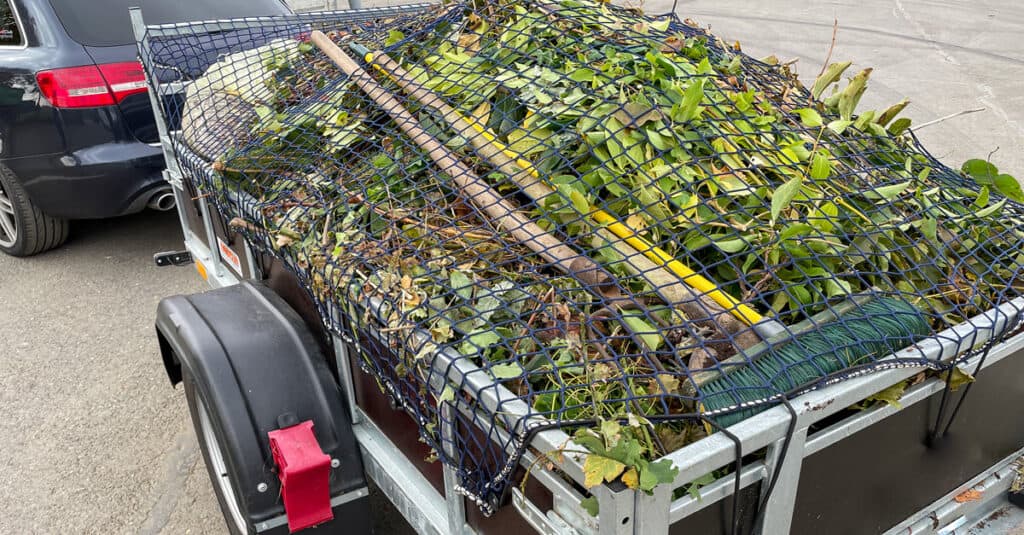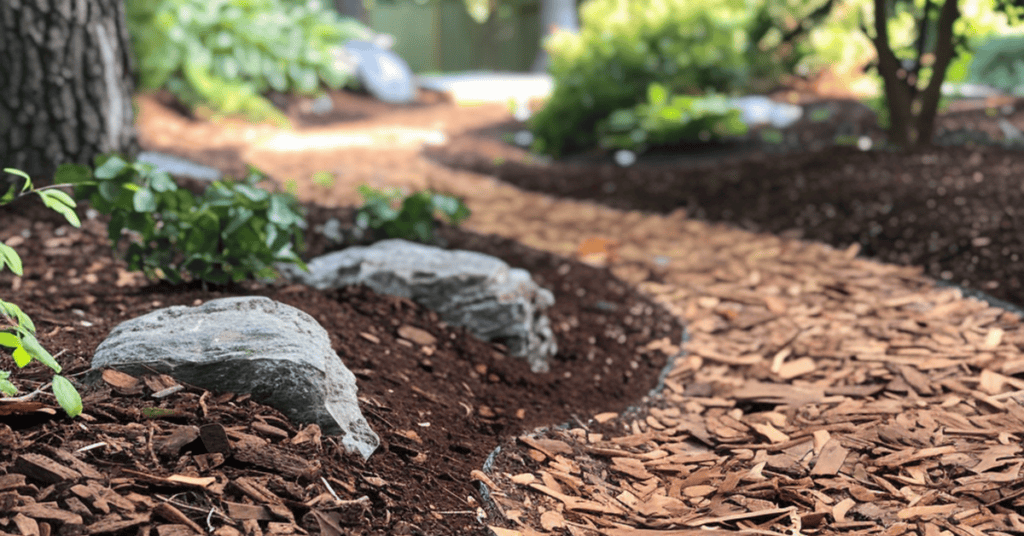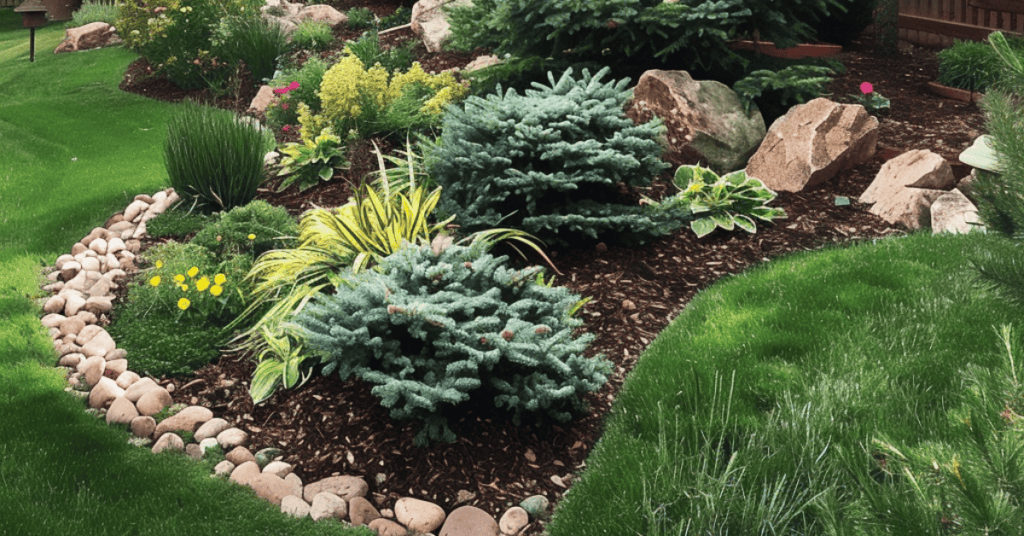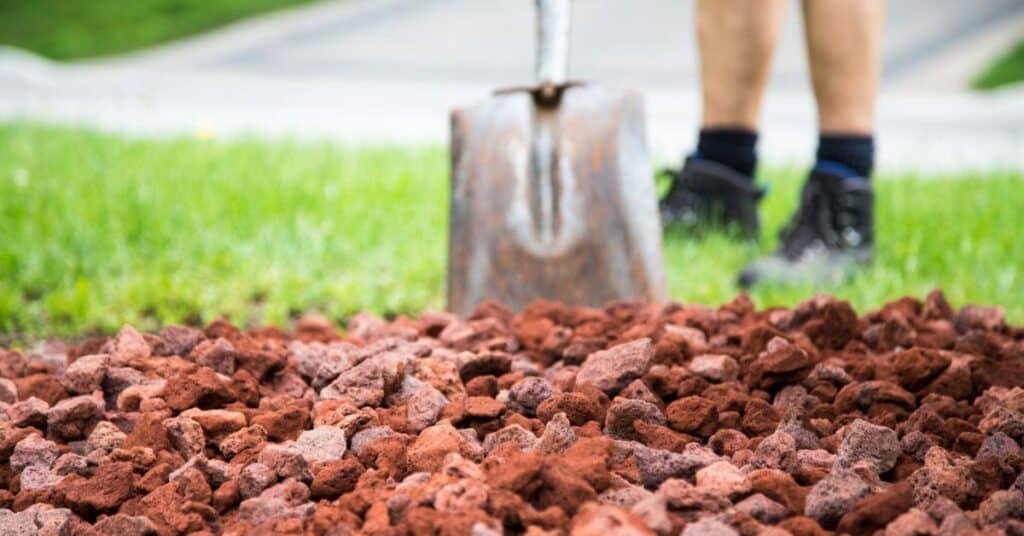River Rock: A Versatile Landscaping Rock
River rock is a landscape rock that offers various benefits for landscaping. This decorative stone comes in different sizes and types, which makes them versatile for multiple uses.
Types of River Rock
River rocks vary in size and texture. Common sizes for this landscaping rock range from ¾ inch to 2 inches. Smaller landscaping stones, around ¾ inch, are perfect for flower beds and pathways.
Medium-sized rocks, from 1 to 2 inches, are well-suited for borders and larger garden areas where you need an eye-catching decorative rock to enhance your landscape design.
Larger rock sizes are great for drainage applications and are used in dry creek beds. They stay in place and still allow proper drainage on your Front Range property.
The landscape stone often comes in colors like white, black, brown, and mixed hues. The smooth texture of these rocks adds visual interest and creates a polished look in any landscaping project.
Benefits of Using River Rock
River rocks serve as a durable and low-maintenance option for landscaping. They last longer than organic mulch and don’t decompose. This makes them ideal for areas with heavy foot traffic or where moisture control is essential.
Their natural appearance enhances the aesthetic appeal, providing a decorative element. Additionally, they help prevent weed growth and improve drainage, which is beneficial for plant health.
Comparing River Rock to Other Natural Stone and Mulch Options
Having covered the pros and cons of river rock, we’ll now take a look at how river rock compares to other landscaping stone options.
River Rock vs. Organic Mulch Options
When comparing river rock to other mulch options, several factors stand out. Organic mulches, like bark or wood chips, decompose over time, requiring regular replacement. They enrich the soil but can attract pests.
River rocks, on the other hand, are permanent and free of pests. They don’t break down to enrich the soil but instead offer excellent drainage and erosion control.
River Rock vs Lava Rock
Lava rock is lightweight and porous, which makes it easier to handle and excellent for improving soil aeration and retaining moisture. Its unique texture and dark color add a dramatic, modern touch to landscapes. However, lava rock can be more abrasive and may break down over time, potentially requiring more frequent replacement. Additionally, Lava Rock can be quite expensive when compared to River Rock.
River Rock vs Landscape Glass
Landscape glass, on the other hand, is made from recycled glass and comes in a variety of vibrant colors, adding a striking, contemporary aesthetic to outdoor spaces. It is lighter than river rock and easier to handle, and its reflective properties can enhance garden lighting. The main drawback of landscape glass is that it is extremely expensive. River rock cost is a fraction of what you would pay for landscape glass.
River Rock vs Decomposed Granite
Decomposed granite consists of small, fine particles that create a compact, stable surface ideal for pathways, patios, and driveways. It is generally more affordable and easier to install than river rock, providing a natural, rustic look. However, decomposed granite can become muddy in heavy rains and may require periodic replenishment as it erodes over time.
River Rock vs Pea Gravel
Pea gravel, on the other hand, consists of small, rounded stones typically about the size of a pea, and is available in a range of colors. This small landscape gravel is more affordable and easier to handle and install than river rock, making it a popular choice for walkways, driveways, and play areas. However, pea gravel can shift underfoot, making it less stable for walking and prone to scattering, which may require regular maintenance. Additionally, it may not provide the same sophisticated look as river rock.
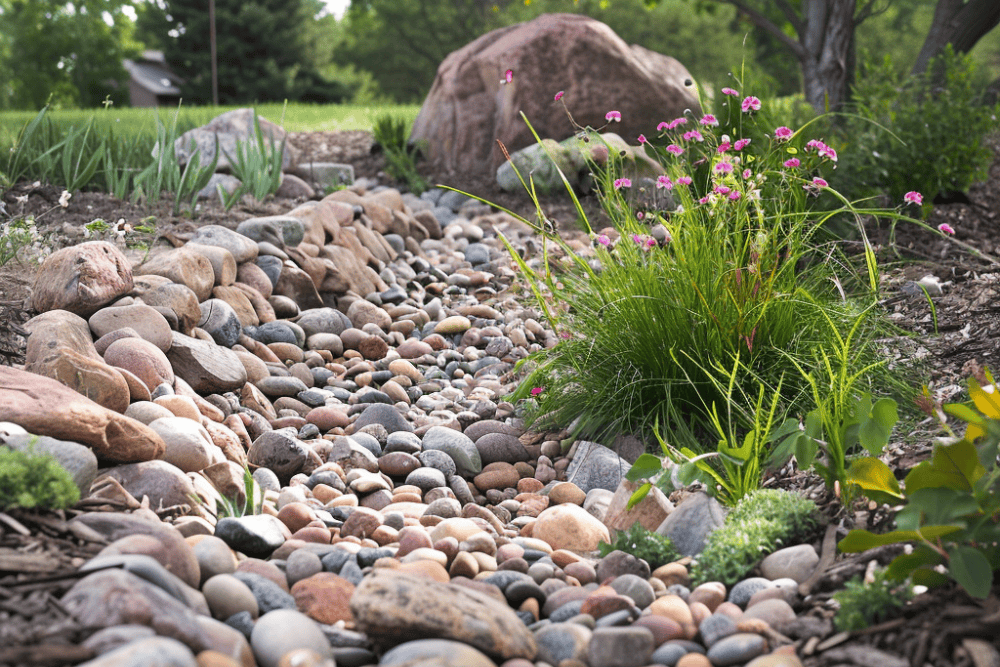
River Rock Stays in Place and is a Better Option for Drainage Applications than Pea Gravel – Which Can Shift When Pressure is Applied
Selecting the Right Size for River Rocks
Size Considerations for Garden Beds
When selecting river rocks for garden beds, you’ll want to go with a smaller landscaping rock size. Rocks ranging from 3/4 inch to 2 inches in diameter are ideal. This size allows for effective mulching, helping to retain soil moisture and prevent weed growth.
Smaller river rocks are easier to spread evenly across the soil. They also create a clean, neat appearance which complements a variety of plantings without overshadowing the plants. Additionally, their size makes them good for adding contrasting textures to the garden.
Best Sizes for Pathways and Walkways
For pathways and walkways, 1-inch river rocks are highly recommended. These rocks are small enough to be comfortable to walk on but large enough to stay in place. Their size helps in creating a stable and non-slippery surface, essential for safety.
River rocks measuring 1-3 inches are another option for pathways. This size spectrum helps to fill gaps more effectively, creating a natural look. Larger rocks might be needed on sloped paths to prevent erosion.
River Rocks for Edging and Borders
When it comes to edging and borders, 3/4 inch to 2-inch river rocks are typically used. This size range works well to create a defined, neat edge around flower beds, trees, or pathways. They provide a decorative element while also serving a practical purpose by keeping soil and mulch in place.
For more prominent borders, larger rocks that are 4-6 inches in diameter can be used. This size lends a more dramatic, sturdy look to the landscape. They are particularly effective at creating visual boundaries and can also be used for small retaining walls.
Careful selection of river rock sizes for specific landscaping purposes ensures functionality and enhances the beauty of the outdoor space.
Functional Uses of River Rocks
River rocks serve many practical purposes in landscaping, providing solutions for drainage, ground cover, stability, and are even ideal for use in a water feature – like a pond or fountain. These stones offer both aesthetic and functional benefits, making them a versatile choice for various landscape design projects.

Boulders and a Mix of Large and Small River Rock and Pea Gravel to Enhance a Water Feature
Drainage and Ground Cover
River rocks are excellent for improving drainage in gardens and yards. They allow water to flow freely, preventing waterlogging and soil erosion. This makes them perfect for use in areas prone to heavy rainfall.
Using river rocks as ground cover helps retain soil moisture while reducing weed growth. They create a clean, finished look, ideal for pathways or garden beds.
For those looking to enhance the functionality of their landscape while maintaining a natural appearance, river rocks are a practical choice.
Stability in Landscape Design
Stability is a key factor in landscape design, particularly on slopes or uneven ground. River rocks provide excellent stability due to their weight and interlocking nature.
These rocks can be used to create terraces or retaining walls, preventing soil erosion and maintaining the integrity of the landscape. Their heavy and solid nature makes them perfect for edging flowerbeds or paths, ensuring that the soil stays in place.
By incorporating river rocks, landscapers can achieve a stable and durable design that withstands various weather conditions.
River Rocks in Water Features
River rocks are commonly used in water features such as ponds, fountains, and dry river beds. Their smooth texture and natural look make them ideal for creating realistic and beautiful water environments.
In fountains and pools, these rocks help conceal pumps and other equipment, enhancing the visual appeal. They also provide a natural habitat for aquatic plants and animals.
For dry river beds, river rocks mimic the appearance of a flowing stream, adding a unique and eye-catching element to the garden. This type of feature is low-maintenance and provides excellent drainage, making it a popular choice in xeriscaping.
Aesthetic Considerations for River Rock
When choosing river rocks for landscaping, aesthetic considerations like texture and color play a vital role. These elements can create drama and visual interest, especially when used in rock gardens and as decorative elements.
Creating Visual Interest with Texture and Color
River rocks vary in texture and color, offering endless possibilities for creating unique landscapes. The smooth, rounded surfaces of river rocks add a pleasing aesthetic to garden beds and pathways. Colors range from neutral grays and browns to vibrant reds and yellows.

River Rock is a Great Choice for Dry Creek Beds. Add a Large Boulder or Two to add Character and Define Boundaries for the Dry Creek
Using a mix of textures and colors can enhance the landscape’s visual appeal. For example, combining light-colored rocks with darker tones creates contrast and interest. It is important to choose colors that complement the surrounding plants and structures.
Incorporating River Rocks into Rock Gardens
Rock gardens are a popular way to use river rocks because they are low-maintenance and visually striking. Smaller pebbles can fill in gaps between larger stones, creating a natural look.
Arranging river rocks in patterns adds visual interest and mimics natural landscapes. Use rocks of varying sizes and shapes to create depth and texture. For added effect, plant drought-resistant plants among the rocks to bring in additional color and life.
Using River Rocks as Decorative Elements
River rocks work well as decorative elements in many settings. They can line pathways, edge flowerbeds, or surround water features. Smooth and polished river rocks add a neat, clean edge to any garden space.
In water features, river rocks create a natural appearance and help with drainage. Their versatility makes them suitable for both small and large landscaping projects. Additionally, they can be used to highlight focal points, like a fire pit or statue, drawing attention and adding to the landscape’s overall beauty.
By considering texture, color, and placement, homeowners can use river rocks to enhance both the aesthetics and functionality of their outdoor spaces.
Installation and Maintenance
Installing river rock in a landscaping project involves careful planning and execution to ensure the rocks serve their purpose effectively. Maintenance includes regular weeding, using landscape fabric, and keeping the area neat.
Laying River Rock
To begin, clear the area where the river rocks will be placed. Remove any debris and level the ground. It’s important to lay down landscape fabric to prevent weed growth. Cut the fabric to fit the area and secure it with stakes.
Next, distribute the river rocks evenly over the fabric. Use different sizes for variety and better coverage. For a polished look, arrange larger rocks at the edges. This helps contain the smaller rocks and prevents them from spreading out.
Preventing Weed Growth
To stop weeds from invading the river rock landscape, use landscape fabric as a base layer. This fabric blocks sunlight, preventing weeds from growing through the rocks. Additionally, applying a pre-emergent herbicide can help reduce the chances of weed seeds germinating.
Mulching the area around plants with a thin layer of smaller river rocks can further inhibit weed growth. Regular maintenance, like pulling weeds by hand or applying herbicide, ensures your landscape remains tidy and weed-free.
Long-Term Upkeep of River Rock Landscaping
Maintaining a river rock landscape requires periodic checks and small upkeep tasks. Inspect the area regularly for debris, fallen leaves, or dirt, which can accumulate and cause weeds to grow. Use a leaf blower or a gentle wash with a hose to clean the rocks.
Sometimes, rocks may shift or sink. Replacing and repositioning the rocks helps maintain a neat appearance. If weeds appear, remove them promptly to prevent spread. Regular maintenance keeps the landscaping looking fresh and well-kept.
